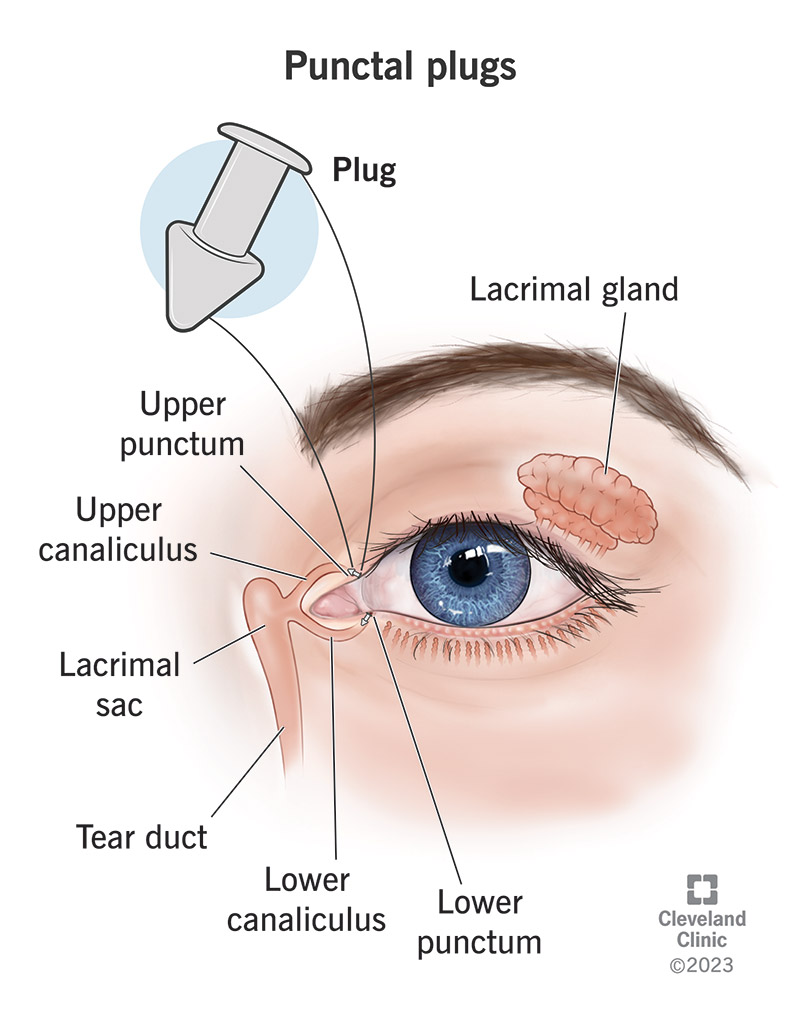Punctal plugs are tiny devices that a healthcare provider can insert into your puncta, the small openings that drain tear fluid from your eyes. These devices slow or stop tear fluid drainage, reducing or preventing dryness in your eyes. They can work as a treatment on their own or make other treatments even more effective.
Advertisement
Cleveland Clinic is a non-profit academic medical center. Advertising on our site helps support our mission. We do not endorse non-Cleveland Clinic products or services. Policy

Punctal plugs are small inserts that block the outflow of tear fluid from your eyes. Blocking that outflow can help maintain eye moisture and keep your eyes from drying out.
Advertisement
Cleveland Clinic is a non-profit academic medical center. Advertising on our site helps support our mission. We do not endorse non-Cleveland Clinic products or services. Policy
Your eyes have a built-in drainage system for tear fluid. The first component in that system is a pair of circular openings called puncta (the word for one is “punctum”). Each eyelid has one punctum near the inside corner of your eye, so both eyes have two puncta. Each punctum is tiny — about the width of three human hairs.
The puncta are like drains that send tears into the nasolacrimal duct, which drains into your nose (which is why you get nasal congestion when you cry). Punctal plugs block the puncta, keeping tears from flowing out.
Punctal plugs come in many different types. Some are designed for temporary use, while others are meant to stay indefinitely. There are also plugs that have specific features to treat certain conditions.
One way to classify the different types of plugs is by the material in them and how long they last:
Advertisement
There are also two specific variants that offer different benefits:
Punctal plugs mainly treat dry eyes, which typically happen when there’s an issue with your tear quality, causing them to evaporate too quickly, or if your tear glands don’t make enough tears to keep your eyes from drying out. Dry eyes can happen on their own or it can be due to other conditions or circumstances. Those conditions include:
A dissolvable type of punctal plug was developed in 1961 as a treatment for dry eyes. The invention of non-dissolvable silicone punctal plugs followed in 1975. These plugs work similarly to placing a stopper in a bathtub. The water level in the tub rises because it can’t drain out.
Perforated punctal plugs can also treat epiphora (watery eyes) from punctal stenosis, which is when the puncta are narrowed by something and it’s hard for tear fluid to drain.
Placing punctal plugs is a straightforward, quick and painless procedure. Your healthcare provider may use a topical anesthetic to numb your eyelid so you don’t feel discomfort. They’ll also likely use some kind of lubricant to make it easier to place the plug.
Your provider will hold your eyelid open and use a special tool to place the plug. It might look like the plug is going near your eye, but it isn’t going to touch your eye itself. While placing the plug, you might feel a little pressure or a slight tug on your eyelid as the plug goes into the punctum (you might not feel anything if your provider applied a topical anesthetic). Once the plug is in place, that’s it.
The type of plug and how long it needs to stay in place depend on multiple factors. Your healthcare provider can tell you more about the exact material that makes up the plugs, how long the plugs last and how long they should stay in.
Punctal plugs have many benefits, including:
Advertisement
Multiple studies over the last 30 years show that punctal plugs are effective. The effectiveness depends on multiple factors, including the specific type of plug, the condition it treats and more. Effectiveness in all but one study was over 70% (the one that showed lower effectiveness had 36 participants, and the success rate was 50%).
Punctal plugs do have a potential for side effects or complications, but these are usually minor. The most common side effects or complications are:
Rare complications include:
Advertisement
Punctal plug placement is quick and straightforward. Depending on the type of plug and whether or not you use any other treatments for dry eyes, you should notice a decrease in eye dryness within days or even hours.
Your healthcare provider is the best source of information on how to help yourself and avoid issues after the placement of punctal plugs. Some general guidelines include:
If you have punctal plugs in place, you should call your provider if you experience any of the following:
Advertisement
Punctal plugs are tiny medical devices, but they can make a big difference in how you see and how your eyes feel. While it might feel uncomfortable to think about a provider placing one of these in the puncta on your eyelids, these devices are effective and safe, and complications or side effects are minor and rare.
If you have dry eyes or similar conditions, punctal plugs might offer you relief or help other treatments work better. That way, you can focus on the things in your life you want to prioritize and worry less about how your eyes feel.
Last reviewed on 09/14/2023.
Learn more about the Health Library and our editorial process.